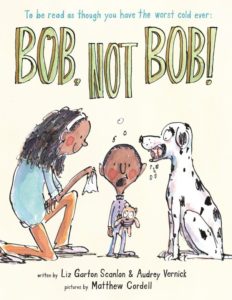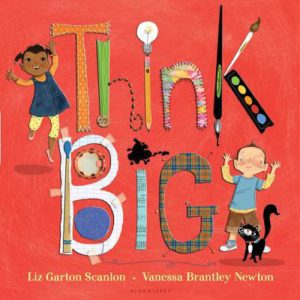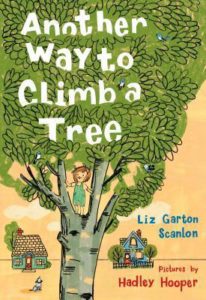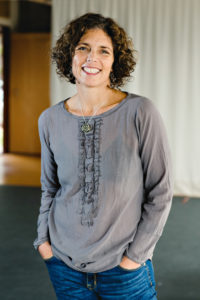 This month’s author interview is with Liz Garton Scanlon. I had the pleasure of witnessing two days of her talking about picture books at the June 2018 SCBWI Summer Workshop in Orlando. Let’s be clear—I filled two pads of paper with scribbles/notes.
This month’s author interview is with Liz Garton Scanlon. I had the pleasure of witnessing two days of her talking about picture books at the June 2018 SCBWI Summer Workshop in Orlando. Let’s be clear—I filled two pads of paper with scribbles/notes.
She’s got bunches of things worth sharing as introductory bio material, but let’s just focus on the 10 factoids about her that I find most fascinating. Without further ado, they are:
- She “wrote an overly long autobiography in second grade.”
- She’s lived in Colorado, Wisconsin, Ohio, England, Colorado (again), California, and Texas, where she has since lived for many years. (Austin, Texas shout out!)
- She aspires to one day beat her family at board games.
- She has “dozens of cousins.”
- She has “very curly hair.”
- She is “darn good at shuffling cards.”
- She teaches at the Vermont College of Fine Arts.
- Her dream breakfast? Strong coffee and gingerbread pancakes.
- She works, mostly, in a “closet-sized studio at an old library table.”
- Joanne Woodward narrated a video Liz’s second book, All the World.
And the bonus factoid #11? She’s the author of lots of picture books, including these three (below) that I dig quite a bit.
Website: http://lizgartonscanlon.com
Facebook: https://www.facebook.com/liz.g.scanlon
Twitter: https://twitter.com/lgartonscanlon
LinkedIn: https://www.linkedin.com/in/liz-garton-scanlon-8045533/
RVC: I can see where degrees in journalism and English can lead you to the path to writing for kids. Same with editing a poetry journal. But corporate marketing communications? Was writing picture books an antidote to that? Or did that offer you skills that translated better than one might expert to writing picture books?
LGS: Ha ha—this question makes me laugh! YES, writing picture books is an absolute antidote to writing corporate communications. I left that job after one too many conference calls sent me to bed with a migraine. When I finally got up, I knew I was done.
That said, the work served me in many ways. First, it made it possible for us to have babies, pay our mortgage, and send my husband to graduate school all at the same time! But also, corporate work provided a steep learning curve in subject matter that was new to me since it required precision on a deadline and it asked for brevity and flair. I think I got to be a better writer through all that, so I’m thankful.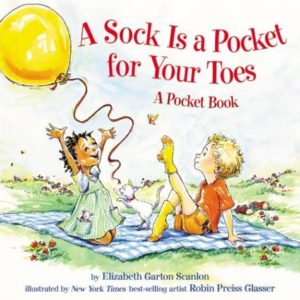
RVC: A Sock Is a Pocket for Your Toes is a fun title. That was your first picture book, too, right? What’s the story of how that came to be?
LGS: Yep, that was my first book. I wrote it when my eldest daughter was a baby. I was getting her dressed one day and said, “Look, a sock is a pocket for your toes!” and instantly, I was flooded with more than enough pocket metaphors to fill a picture book! But it wasn’t just my first book—it was also a mini-education in writing rhyme for kids. I had submitted a manuscript that was, metrically, very loose—almost free form—and my editor asked for exactitude. Predictable syllabics and rhythm for the read-aloud set! This makes sense when you think about it, but it was a tough lesson to learn because revising rhyme is excruciating.
RVC: Let’s talk about rhyme a bit more. Pretty much everyone likes it … when it’s done well. How DOES someone write/revise for rhyme? Any strategies? Tips?
LGS: Oh, rhyme. It’s so good when it’s good, isn’t it? So musical. So memorable. But boy, is it tricky. Here’s the thing—it’s more than coming up with a few decent end rhymes. It’s coming up with perfect end rhymes that actually serve the story at hand. That say what we want them to say. That say what the story needs (rather than forcing an illogical digression just to make the rhyme work). And it’s about perfect meter, too. Rhyme is nothing without meter, so we need a regular syllabic pattern along with the rhyme scheme, and we need to make sure we’re not having to put the emPHAsis on the wrong syLABble when we read it aloud.
As for revising, we must be willing to unravel the whole thing if necessary. We tend to think that once rhyme is drafted, it’s sacrosanct. But sometimes we have to pull it apart—and even toss out darn good lines—to get it right.
RVC: On one hand, the story of how A Sock Is a Pocket for Your Toes is one of those easy-peasy it-worked-like-magic tales, right? But didn’t it also have quite a few hiccups/challenges along the way?
LGS: Sure, every book has its hiccups. And speaking of rhyme and meter, I wrote and submitted that manuscript with no discernible pattern to it at all. I thought I was composing jazz, and that the variations were creative and fun! My editor helped me see that I was making it almost impossible to read aloud and I’d done away with all the rhythmic predictability that makes rhyme so pleasurable to kids. Honestly, A Sock Is a Pocket for Your Toes served as my own mini picture book boot camp, and I needed it.
RVC: Your Caldecott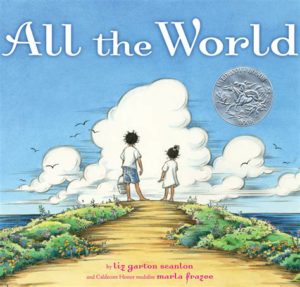 -honored picture book, All the World, was illustrated by Marla Frazee. What was it like working with her?
-honored picture book, All the World, was illustrated by Marla Frazee. What was it like working with her?
LGS: I was a serious devotee of Marla’s work long before she was my illustrator or my friend. In fact, our first-ever contact came via a fan letter I wrote her after reading the Clementine books with my girls. Her illustrations in All the World made the book what it is—a physical place of beauty and comfort and communion open to every reader. And making it together was, really, a deep pleasure. The process was more collaborative than most picture book projects in that we spent time over many months—via phone and email, and with our editor Allyn Johnston of Beach Lane Books—massaging the text and illustrations until the marriage was just right.
I’ll always treasure that experience and the final product.
RVC: Speaking of collaborations … you’ve successfully written picture books with Audrey Vernick. What’s your secret? What do you get out of collaborating? How do you make it work so well?
LGS: Key to collaboration is admiration and connection and respect. If I didn’t adore Audrey and her writing—and vice versa—I don’t think this would work. Also, we do something kind of brave (or crazy)—we write by passing a Word doc back and forth, and we don’t use comments or edit mode. At all. When it’s our turn, we just add and delete and amend as we see fit. Without permission. We take absolute ownership—until it’s time to send it on. In that way, the piece is completely ours and then again, not ours at all. The result is that we’re deeply engaged but not egoic, which is good for the work and our own well-being. Also, it’s really fun.
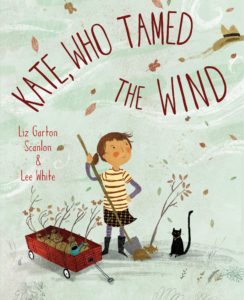 RVC: While I’m sure that you had some degree of fun while writing of all of your books, it seems that Kate, Who Tamed the Wind might’ve also provided a lot of challenges for you. Far more than usual, right?
RVC: While I’m sure that you had some degree of fun while writing of all of your books, it seems that Kate, Who Tamed the Wind might’ve also provided a lot of challenges for you. Far more than usual, right?
LGS: That book. Oh, mercy. It took more than fifteen years from idea to publication. And more than 100 drafts. There are rhymed and unrhymed versions. Versions with a man, a woman, a little boy, a little girl. Versions written in past tense and present.
Honestly, if there was something to try, I promise you I tried it. What I wanted, in the end, was something lyrical, relational, environmental, cumulative, mystical, personal, read-aloudable—and I guess it just took me a long, long time to achieve all that.
RVC: Let’s talk about the drafting process. You’ve got an interesting idea regarding the value of those first drafts.
LGS: Anne Lamott talks about “shitty first drafts,” and this is just my version of that. I constantly remind myself that a first draft doesn’t have to be lovely. It doesn’t have to flow, or be the right shape or length. It doesn’t have to be good at all! It just has to reveal itself to me.
It’s a place where I get to bumble about, where I get to walk myself into the story—to tell myself the story. Once I’ve done that, then it’s time to figure out how to tell it to everybody else.
RVC: Speed round! Hardest word you’ve ever managed to rhyme well.
LGS: Oooo, I’ve got a few. Lemonade. Steadfast. Strut. I do love the puzzle of a good rhyme!
RVC: An illustrator you’d love to work with on a future book of yours.
LGS: I have SO MANY ILLUSTRATOR DREAMS. Many of them, of course, have been answered! (I’ve been very, very lucky in this regard.) As you know, I just spent a day teaching with Floyd Cooper at the Florida SCBWI conference and I love that man and his work, so that would be pretty great. But I’m also always yearning to work with up-and-coming female illustrators who are still having a harder time getting noticed in the picture book world. More than half my books have been illustrated by women and I’m liking that track record.
RVC: If you had to write longhand, would you use a pencil or pen?
LGS: Pencil—as long as it was really sharp.
RVC: If you never became a writer, you’d instead be …
LGS: A lawyer. I like arguing and I did well on the logic portion of the GRE. So, yes. A lawyer … but living on a horse farm.
RVC: Best late-night snack?
LGS: Popcorn with chili powder and brewer’s yeast.
RVC: Favorite non-kidlit genre to read?
LGS: I always have a novel, a collection of short stories, and a book of poetry on my bedside table. I choose based on time of day, emotional state, and exhaustion level.
RVC: Best compliment a child could ever give you about one of your books?
LGS: “I’m gonna write a book like this someday.”
RVC: Thanks oodles, Liz!


